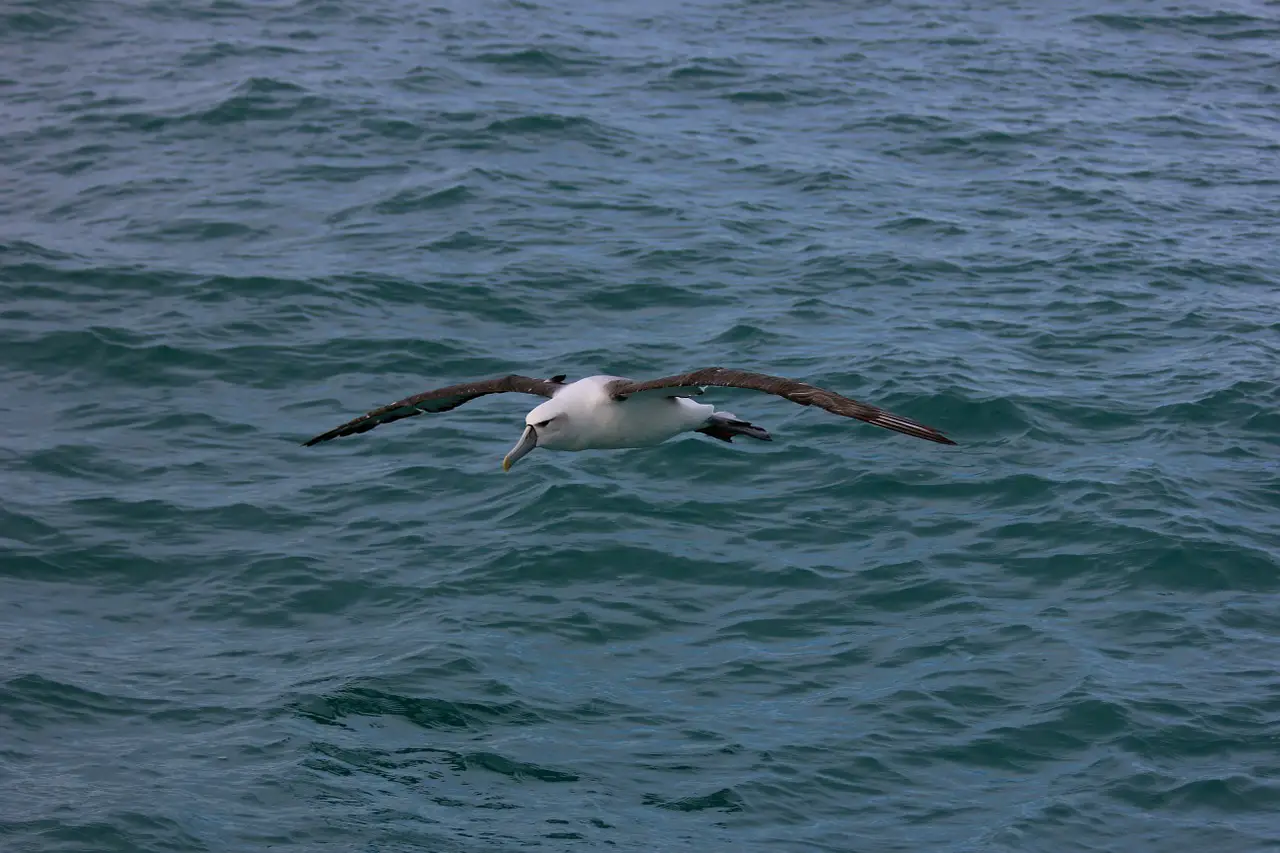Part of the Diomedeidae family, the Albatross is one of the largest flying birds and one of the best at gliding. Although there is disagreement and an official count is yet to be reached, the IUCN (International Union for Conservation of Nature) and BirdLife International recognize 22 species of Albatross. However, not all of these can be found in North America.5
There are three species of Albatross in North America. The Black-footed Albatross and the Laysan Albatross can be found in the Hawaiian Islands, while the Short-tailed Albatross can be found off the coast of California.
Albatross spend most of their lives at sea, only coming ashore to nest. They have long, pointed wings and are effortless flyers. Albatross have bills formed of plates separated by sutures. They have long, webbed front toes while a web does not connect the hind toe.
Albatross, along with other family members such as Shearwaters and Petrels, have a stomach oil which they can eject when disturbed. The oil is used toward predators or other birds. The oil can cause the matting of a bird’s feathers leading to loss of flight or waterproofing.
The oil is also used as an energy store and can be fed to chicks or as a backup energy supply when flying over the ocean.
The stomach oil, created by the digestion of their prey such as squid, krill, and fish, has a strong odour that can prevent mammals from attacking them, even if it is not dangerous.

Albatross are distributed in four genera: Great Albatross, North Pacific Albatross, Mollymawks, and Sooty Albatross. Only North Pacific Albatross can be found in North America. The Black-footed Albatross, which are brown, and the Laysan Albatross, which is white-coloured with dark upper wings, are the species most commonly seen on the Pacific coast.
Species in the Great Albatross genera have the largest wingspan, measuring up to 3.7m (10′). Thanks to their large wings, Albatross can glide for hours without a single flap of their wings, even in windy conditions. They can often be seen soaring over the sea, travelling as far as 1,000 km per day.
Albatross can be found on isolated islands and only come ashore to breed. Albatross mate for life, reaching sexual maturity at about five years, although they may not breed until sometime after. There is evidence that Albatross can live as long as 50 years.
When they gather to breed, albatross form colonies, and young members usually attend the breeding rituals to practice their display for which the birds are famous. This ritual includes a dance that features the stretching of wings alongside loud squealing and groaning, staring, as well as bill clacking.
Using rudimentary nests, Albatross lay only one single egg, and it is incubated and taken care of in equal measure by both parents. The incubation process lasts from 70 to 80 days, depending on the species. Due to the length of incubation, both parents can lose a considerable amount of weight.
Chicks are taken care of for a couple of weeks after hatching until they can protect themselves and regulate their temperature. However, their plumage grows slow, and it can take up to 10 months before they can adequately fly.
Their diet relies mainly on squid, but this can vary from one species to another. They also feed on fish, crustaceans, krill, and zooplankton. Most species of albatross fish on the surface, but some also dive to catch their prey. They can be seen landing on ships to eat garbage from time to time. Albatross typically feed during the day and can be seen drinking seawater.
There are many ways that young birds are fed. Find out more here
Black-footed Albatross
The Black-footed Albatross can be identified as it is the only dark Albatross of North America. They also have a white horseshoe shape on their rump.
They measure up to 30-34 in (76-86 cm) long with a wingspan up to 7.2 feet (220 cm) and weigh up to 3.4 kg (7.5 lb.)
Their underwing shows a series of bars, and the undertail is white. They have a slightly pale area around the eye and the base of the bill.
They are silent while at sea with no distinctive calls. They can be found along the Pacific coast throughout the year but can be more often spotted during summer. They can also be found in the Hawaiian Islands, where they breed.
Laysan Albatross
The smallest species of Albatross in North America is the Laysan Albatross, with an average wingspan of 196 cm (77 in) and a bodyweight of 2 to 4 kg (4.4 – 8.8 lb.)
Laysan albatross live in the northwestern Hawaiian Islands and are the most widespread species of Albatross of North America. Their population is around 2.5 million birds, with the population still growing.
They have dark wings with black contrast and a white body. Their tail is black, while their underwings are primarily white with a black pattern. They have a dark mark around their eye.
They are silent at sea with no distinctive call. They can be seen offshore of California and Alaska, although rare. They migrate from their breeding grounds off Hawaii.
Short-tailed Albatross
In North America, the largest species is the Short-tailed Albatross, which has a wingspan of 215 to 230 cm (85–91 in), and body weight between 4.3 to 8.5 kg (9.5–18.7 lb).
They have black flight feathers and a black terminal bar on their tail but are overall white, although juveniles are all-brown until the age of 10-20.
They can be found in the Northwestern Hawaiian Islands, where they breed but also visit the shores of California and Washington.
They are known to follow ships to feed on the garbage and waste they leave behind. Short-tailed Albatross are classed as vulnerable by the IUCN.
Do you know how kestrels hunt? Find out in this article I wrote

